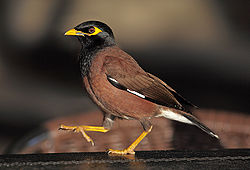| Acridotheres | |
|---|---|
 | |
| Common myna, Acridotheres tristis | |
| Scientific classification | |
| Kingdom: | Animalia |
| Phylum: | Chordata |
| Class: | Aves |
| Order: | Passeriformes |
| Family: | Sturnidae |
| Genus: | Acridotheres Vieillot, 1816 |
| Type species | |
| Paradisea tristis [1] Linnaeus, 1766 | |
| Species | |
11; see text | |
Acridotheres is a genus of starlings, the "typical" mynas , which are tropical members of the family Sturnidae.